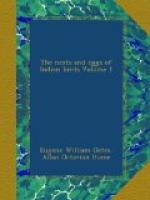The Southern Grackle breeds in Southern India and Ceylon from March to October.
Mr. Frank Bourdillon, writing from Travancore, gives me the following account of the eggs. He says:—“This bird, an abundant resident, lays a blue egg pretty evenly marked with brown spots, some light and some darkish, in a nest of straw and feathers in a hole of a tree generally a considerable height from the ground.
“I have only taken one nest, which contained a single egg slightly set, on 23rd March, 1873, the egg measuring 1.37 long and 0.87 broad.”
Later Mr. Bourdillon says:—“Since writing the foregoing I took on 21st April two fresh eggs from the nest of a Southern Hill-Mynah (Eulabes religiosa). The nest was of grass, feathers, and odds and ends in a hole in a nanga (Mesua coromandeliana) stump, about 25 feet from the ground. The eggs of this Mynah are blue, with purplish and more decided brown spots.
“I am positive as to the identity of the egg. Both the eggs taken last year and the two taken the other day were obtained under my personal supervision. In both instances I watched the birds building, and when we robbed the nests saw the female fly off them.”
These two eggs sent me by Mr. Bourdillon are very beautiful. In shape they are very gracefully elongated ovals; the shell is very fine and smooth, but has only a rather faint gloss. The ground-colour is a delicate pale sea-green or greenish blue, and the eggs are more or less profusely spotted or splashed with purplish, or, in some spots, chocolate-brown and a very pale purple, which looks more like the stain that might be supposed to be left by one of the more decided coloured markings that had been partially washed out than anything else.
The eggs measure 1.37 by 0.9 and 1.35 by 0.87.
Mr. J. Darling, junior, writes:—“The Southern Grackle breeds in the S. Wynaad rather plentifully, and I have had numbers of tame ones brought up from the nest, but have never succeeded in getting a perfect egg owing to my having found all the nests in very hard places to get at.
“I cut down a tree containing a nest and broke all the eggs, which must have been very pretty—blue ground, very regularly marked with purplish-brown spots. The nest was composed of sticks, twigs, feathers, and some snake-skin. I have found them in March, April, September, and October. I hope this year to get a number of eggs, as Culputty is a very good place for them.”
Mr. C J.W. Taylor notes from Manzeerabad in Mysore:—
“Common up in the wooded portions of the district. Breeding in April and May.”




